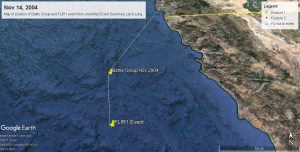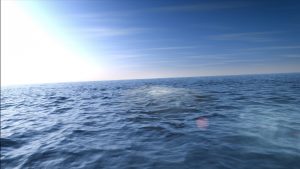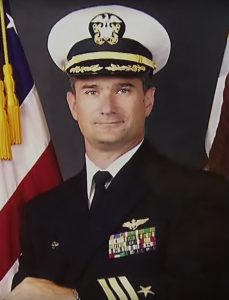This interview was posted on To The Stars Academy of Arts and Sciences Community of Interest website from November of 2017. In this interview Cmdr. Fravor describes the encounter he and his wingman had on November 14th, 2014 while flying training missions from the USS Nimitz aircraft carrier off the coast of San Diego, CA.
“I had just taken over of command of Strike Fighter Squadron 41, the Black Aces we are in the midst of work ups which was a kind of a …there was a two-month At-Sea period from the beginning of November until just before Christmas and in this case we were a little bit Southwest of San Diego, usually about 60 to 70 miles off the coast. I don’t know exactly where it was that that day and we were getting ready to do an air defense exercise. In this event we rendezvous at the CAP (Combat Air Patrol) so we’re gonna come off the aircraft carrier we’re gonna climb up to 20,000 feet. We’re going to go to a point about 40 miles south. We’re gonna hold and wait for the other airplane.

So as the other airplane is joining up on me, the USS Princeton, their controller, calls us up and says “Fast Eagle”, which was the call sign Fast Eagle 101-102, I can’t remember exactly what our numbers were. They said “Hey we’re gonna cancel the air defense exercise and we have real-world tasking.” and I said, “Okay”. And they gave us a vector 270, which means go west. And they start calling out the intercept.
We had our radars made (set) at about 20 miles and we’re looking out. So we’ve got a pretty good swath of the air that we’re scanning. because we start tracking out to the west, they’re calling, “Hey 30 miles”. And they’re giving us what’s called BRA, it’s bearing, range and altitude. So they’re saying, “Hey contact is 270, 30, 20,000”, So they start going, “Hey 20 miles”, Still nothing. We’re not seeing anything on the radar. Ten miles. We’re not seeing anything on the radar. Well we get to a point that they call “merge plot”, which means the contact that we’re trying to see and us are inside the resolution cell of the radar. Which means they can’t discern the two of us. They just see one blob.
So as we’re flying and we’re still heading west. We start looking around. Because of our merged plot, now you’re into a visual arena. You’re not as much worried about your radar. Plus, the WSOs (Weapons Systems Officer in back seat) are gonna do the radar stuff. But we’re still looking out and I look out the right side and I see something in the water. And it looks like about the size of a 737 in the water pointing east. So you don’t see an airplane, but if you’ve ever been out to sea with like an underwater sea mountain, as the waves come and there’s something right under the surface, they’ll break. Same thing that happens on shore. They’ll break and you’ll get whitewater. So this thing looks kind of like that shape. Looks, you know… like if you put a 737 about 10 to 15 feet under the water. The waves are gonna crash over the top and you’re gonna get this whitewater.

So we see that and so he’s pointing the east. So it would be on the right-hand side of the airplane. Just forward of the wing line is this little white thing, which looks like a tic-tac, which is why we call it the tic-tac, and it’s moving around erratically. So it’s doing this. It’s not hovering, you know, it’s not. It’s moving just randomly around. Not fast just kind of left right forward and back. There’s no rotor wash, which you see from a helicopter. It’s just this odd object. And so by this time we passed by it and now I’m starting a right hand turn. So we’re going from a clock-code, from six o’clock towards the 9:00 o’clock position. And I’m like, well that’s interesting. I said, “well, I’m gonna go check it out”.
So at about the nine o’clock, between probably nine and ten, I started an easy descent. And I’m watching this thing and it’s just kind of randomly moving around this vehicle. And it’s basically forward of the right wing by the cockpit and then it goes back and it’s kind of moving around like it was checking it out. That’s kind of odd.
So as we passed through about the twelve o’clock position and we’re descending. It kind of recognizes that we’re there and it starts to mirror us. So now, think of it at the six o’clock position we’re at the 12 o’clock position. We’re coming down and it starts coming up. So it’s going towards nine o’clock and we’re going towards three o’clock. And we do this all the way around until I get all the way back towards about the nine o’clock position. So I’m still coming down nice and easy and I’m watching this thing. Because it’s just kind of watching us and following. And I’m like that’s kind of weird. So now there’s probably about, let me think, 2500, it’s probably about maybe 3,000 feet below us and about a mile across the circle. It’s about the size of an F-18. So you know 47 feet long. But it has no wings. I don’t see any exhaust plume, you know, like an older airplane would have smoke. There’s none of that.
So as I come across, I’m a little above him. He’s at the 3 o’clock position and I go, “well the only way I might get this is to do an aggressive out-of-play maneuver”. So I dump the nose and I go from the 9 o’clock through the vertical down, to go across to the 3 o’clock. So he’s over here and I go like this (motions cutting across the circle). So as I get down to about, I’m probably about 60 degrees nose low a little, pulling through the bottom. It starts to accelerate. It has an incredible rate of acceleration. And it takes off and it goes south. And it takes off like nothing I’ve ever seen. It literally is one minute it’s there and the next minute it’s like, poof, and it’s gone.
So I came up on the radio and I said, “hey let’s just spin around and go back to what was in the water, let’s go see what was in the water.” So right there, it’s kind of below us, you know. So I’m kind of heading to the east. So we do a 180 and go back to the location we’re at and there’s nothing in the water. So I call up the Princeton and I said, ‘hey did you guys, do you guys have all this?” And I was talking back and forth to the controller. We got into more detail of, “hey we’ve been tracking these things. They’ve been dropping from 80,000 feet. They come straight down. They hang out at about 20,000 feet. They monitor them. They’ll just they’ll just sit there. We’ve had nothing airborne. But and then when they’re done they go straight back up and they disappear.” So I say, “Okay”. I said, “Well I said we’re gonna head back to our CAP”.
So which were about 60 miles away, which doesn’t take long in an airplane. So we start going back to the CAP and the Princeton controller calls us up and he says he says, I’ll never forget it, he goes, ”Sir, you’re not going to believe this.” I said, “what? He says, “that thing is at your CAP. It’s hanging out right where you’re supposed to be!””
Cmdr. David Fravor
Ret. Commanding Officer of VFA-41 "Black Aces"

